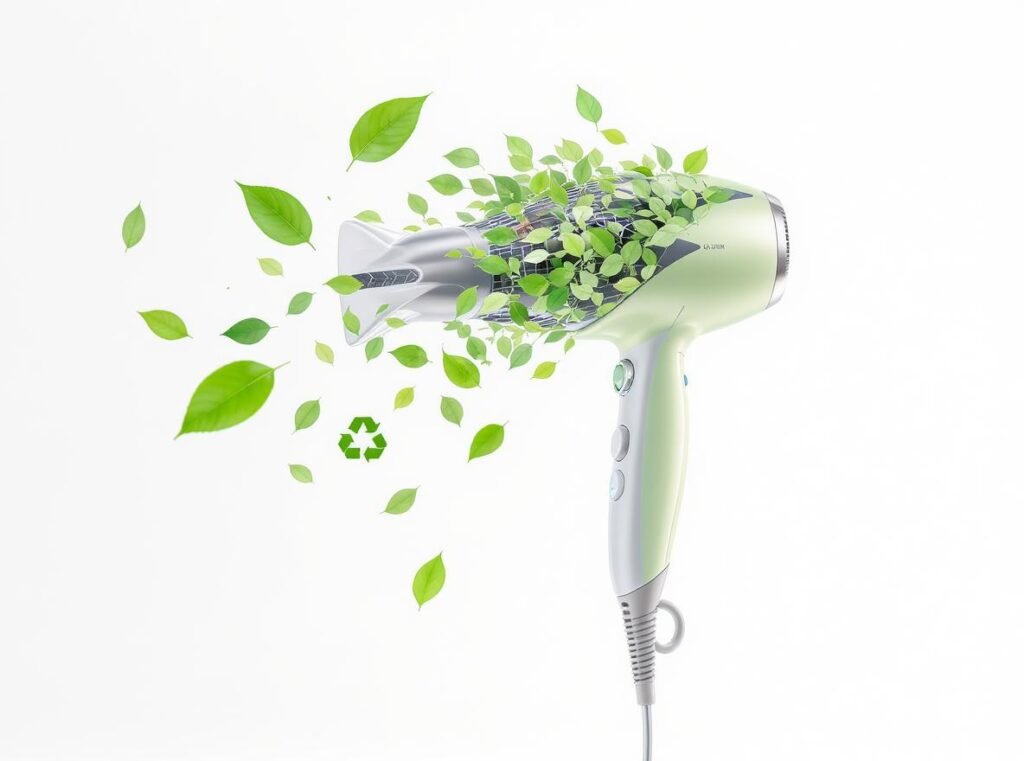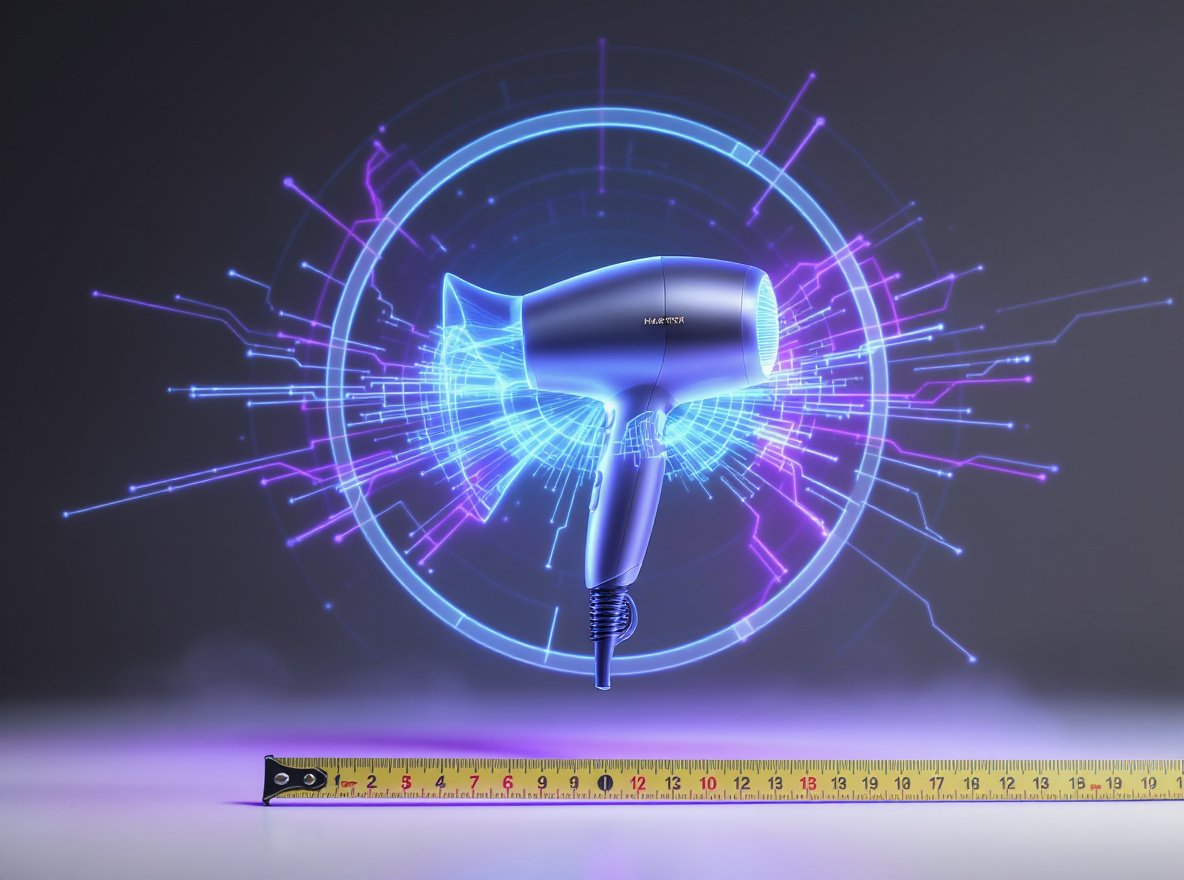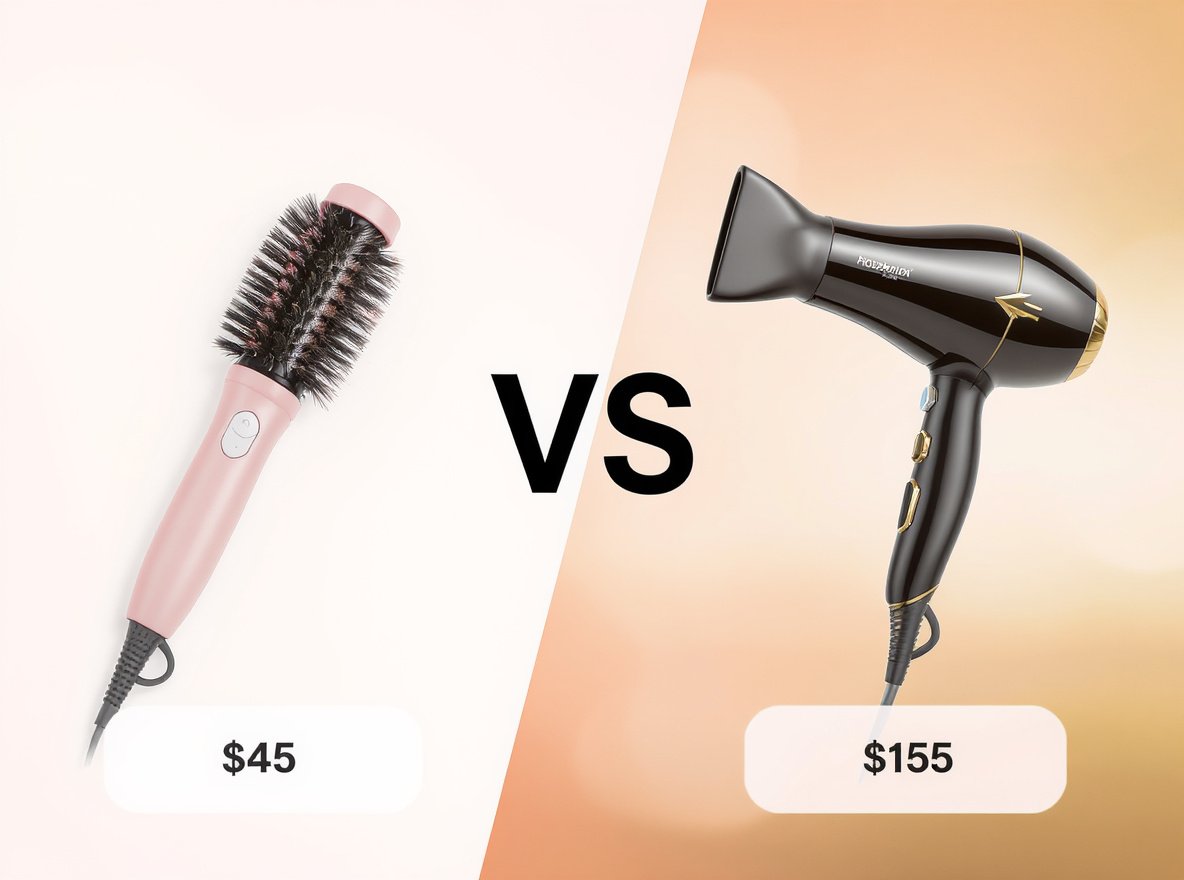The beauty industry is rapidly evolving toward sustainability, and consumers are increasingly demanding eco-friendly alternatives to traditional styling tools. As environmental consciousness grows, many are wondering if truly recyclable hair dryers exist and whether they can make a difference.
Partially recyclable hair dryers are available, with some models incorporating recycled materials and designed for easier recycling at end-of-life. However, fully recyclable hair dryers—where every component is designed for straightforward recycling—are not yet standard in the market.
Let’s explore the current state of recyclable hair dryers and what options are available for environmentally conscious consumers and businesses.
Table of Contents
ToggleWhat Makes a Hair Dryer Recyclable?
Understanding hair dryer recyclability requires examining the materials and components that make up these essential styling tools.
A hair dryer becomes recyclable when its components can be properly separated and processed through specialized recycling programs. Key factors include casing materials that avoid hazardous substances, design for easy disassembly, and packaging made from recycled or recyclable materials.
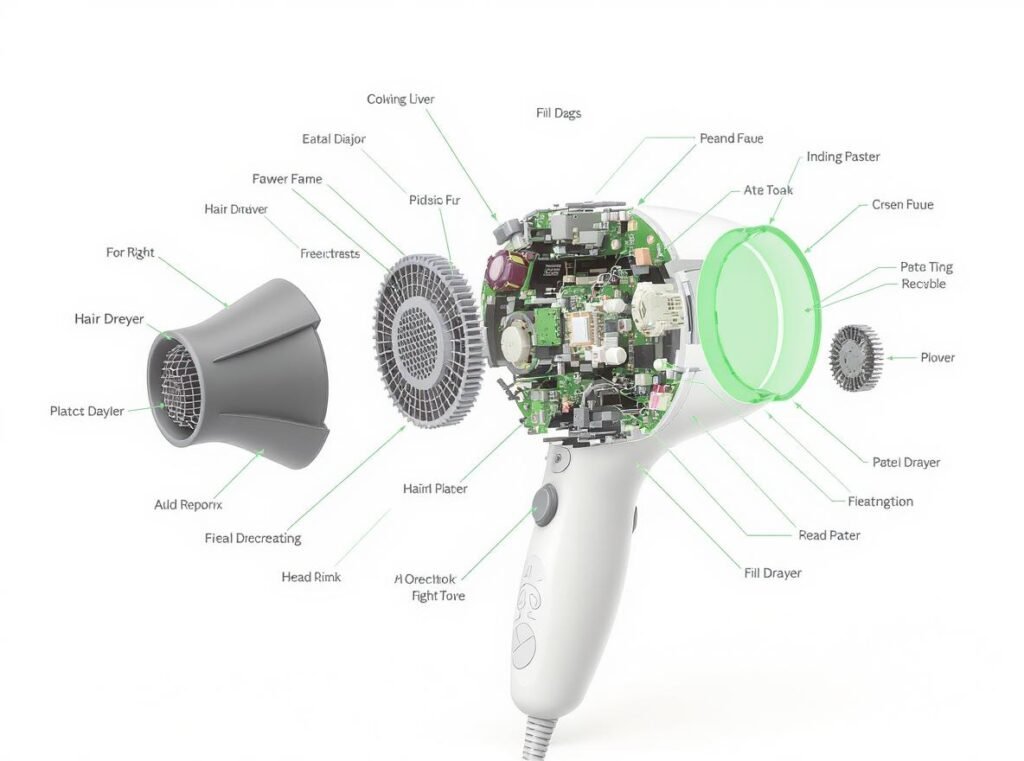
A hair dryer is considered recyclable when several criteria are met:
The casing and internal components must be made from materials that can be separated and processed by recycling facilities. This includes specific types of plastics and metals that recycling centers can handle efficiently.
The design must avoid hazardous substances that complicate recycling processes. Certain flame retardants, heavy metals, and mixed materials can prevent proper recycling and pose environmental risks.
Easy disassembly is crucial for effective recycling. Components should be designed so parts can be sorted and recovered efficiently, allowing recycling facilities to separate metals, plastics, and electronic components.
Sustainable packaging practices also contribute to overall recyclability. Many eco-friendly models now use recycled or recyclable packaging materials, reducing the environmental impact from the moment of purchase.
| Component | Recyclable Materials | Recycling Challenge |
|---|---|---|
| Outer casing | Recyclable plastics | Mixed materials separation |
| Motor housing | Aluminum, copper | Electronic component removal |
| Heating elements | Metal coils | Safe disassembly required |
| Wiring | Copper, metals | Insulation material separation |
| Packaging | Recycled cardboard | Plastic window removal |
Are Fully Recyclable Hair Dryers Currently Available?
The market for truly recyclable hair dryers is emerging, with several manufacturers leading the sustainability charge.
Currently, no mainstream fully recyclable hair dryers exist where every component is designed for straightforward recycling. Most eco-friendly models use a percentage of recycled plastic and recyclable materials, but mixed materials or electronic parts prevent complete recyclability.
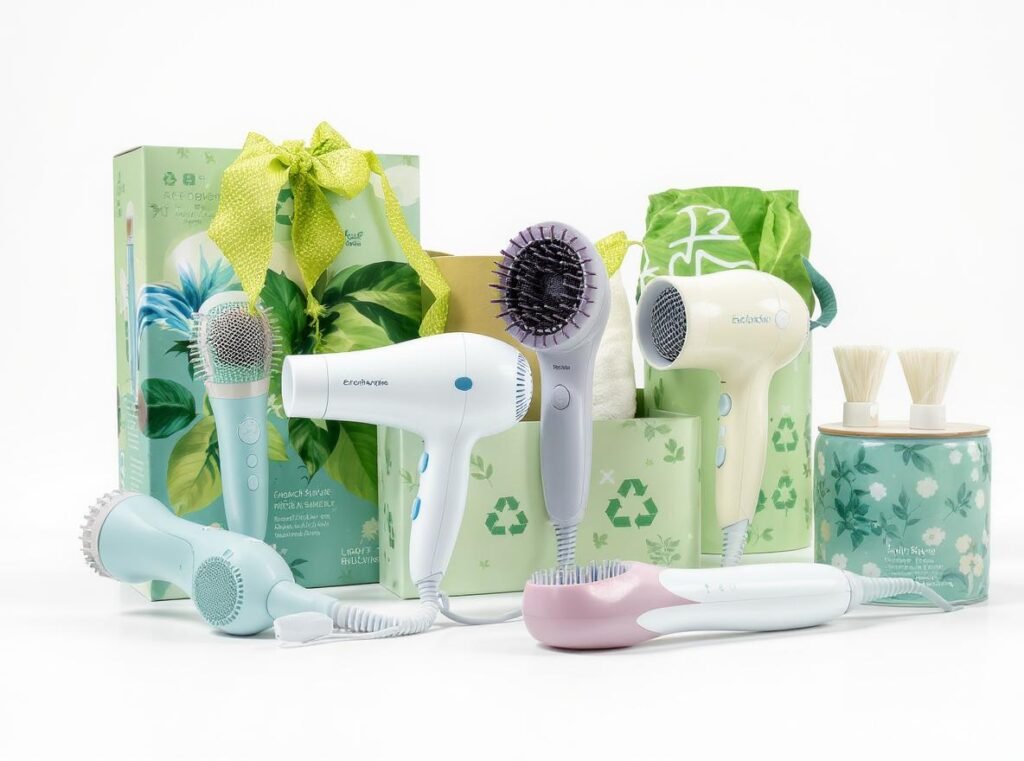
Several manufacturers have introduced more sustainable options with varying levels of recyclability:
The Mermade Hair M Ionic Hair Dryer represents current industry progress, incorporating 20% recycled plastic in its construction along with eco-conscious packaging. This model demonstrates how manufacturers are beginning to integrate recycled materials into their designs.
Parlux offers the 3800 Eco Friendly Dryer, crafted from recyclable materials with recycled packaging. The professional hairdryer Parlux 3800 Eco-Friendly reinforces durability while focusing on environmental responsibility through material selection and energy efficiency.
Twin Turbo produces the 3800 Ceramic Ionic Eco-Friendly model, which emphasizes sustainable materials and long-lasting performance. This professional-grade dryer targets salons seeking to reduce their environmental footprint.
The Ibiza Hair Kristal 3600 focuses on durability and longevity as sustainability strategies. By creating longer-lasting products, manufacturers reduce replacement frequency and overall waste generation.
Even premium brands are joining the sustainability movement. The Rusk Go Green Hair Dryer offers 1400 watts of power while incorporating eco-friendly design principles and materials.
What Are the Current Recycling Options for Hair Dryers?
Understanding how to properly recycle existing hair dryers is crucial for environmental responsibility.
Current hair dryer recycling options include local recycling centers, e-waste recycling programs, donation for functional units, and retailer take-back programs. The recycling process involves sorting, manual disassembly, material recovery, and safe handling of hazardous components.
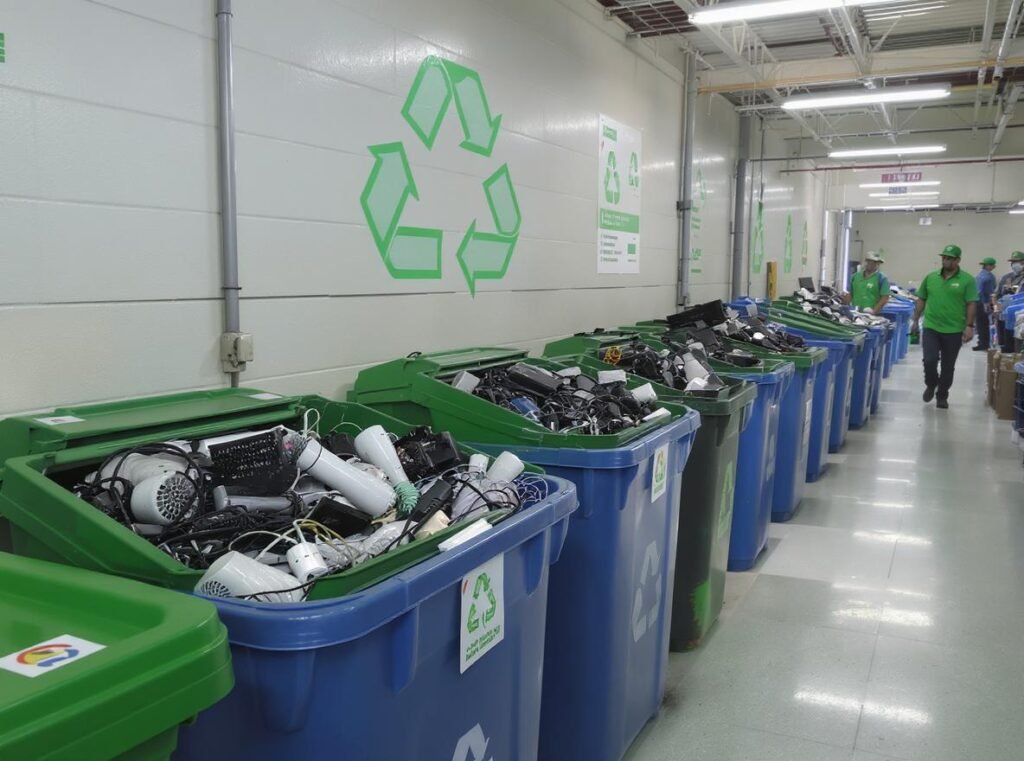
Several recycling pathways exist for hair dryers:
Local recycling centers often accept small appliances like hair dryers, though policies vary by location. Many household waste recycling centers can process these devices through their small appliance programs.
E-waste recycling programs provide specialized handling for electronic components. Organizations like All Green Electronics Recycling focus specifically on processing small appliances and ensuring proper material recovery while protecting environmental safety.
Donation remains viable for functional hair dryers. Thrift stores, charities, and community organizations often accept working appliances, extending product life and reducing waste.
Some electronics retailers offer drop-off bins for small appliances through take-back programs. Best Buy and other major retailers provide convenient recycling options for consumers.
The recycling process typically involves:
- Initial sorting of electronic waste
- Manual disassembly to separate components
- Recovery of valuable plastics and metals
- Safe handling and disposal of hazardous materials
- Processing recovered materials for reuse in new products
Professional recycling services ensure compliance with environmental regulations and maximize material recovery rates.
Which Brands Offer Eco-Friendly Hair Dryer Options?
Several manufacturers are leading the charge in creating more sustainable hair drying solutions.
Leading eco-friendly hair dryer brands include Mermade Hair, Parlux, Twin Turbo, Ibiza Hair, Rusk, Paul Mitchell, and Elchim. These brands focus on incorporating recycled materials, improving energy efficiency, and designing for durability to reduce environmental impact.
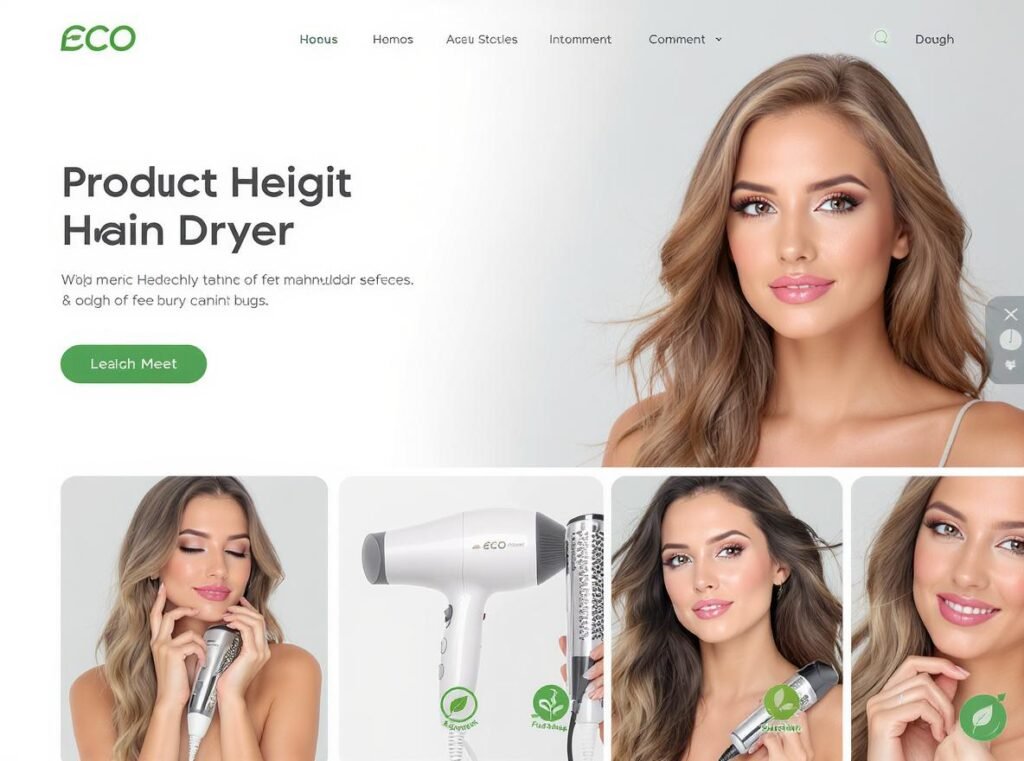
Professional and consumer brands are prioritizing sustainability:
Mermade Hair’s M Ionic Hair Dryer uses 20% recycled plastic and features eco-conscious packaging. This model demonstrates how manufacturers can integrate recycled materials without compromising performance.
Parlux offers multiple eco-friendly options, including the 3800 Eco Friendly model and the Alyon series. These professional-grade dryers emphasize recyclable materials and energy efficiency for salon use.
Twin Turbo’s 3800 Ceramic Ionic Eco-Friendly model combines sustainable materials with professional performance. The brand focuses on durability and energy efficiency in their eco-conscious designs.
Paul Mitchell has established a Tool Recycling Program, accepting old styling tools regardless of brand. This initiative demonstrates manufacturer commitment to product lifecycle management and circular economy principles.
Elchim produces the 3900 Light Ionic model with focus on energy efficiency and sustainable materials. This professional dryer targets salons seeking to reduce their environmental impact.
Rusk’s Go Green Hair Dryer offers 1400 watts of power while incorporating eco-friendly design principles. The brand emphasizes energy efficiency and sustainable manufacturing practices.
The Conason P1C represents advanced high-speed technology with sustainability considerations. This professional-grade dryer incorporates energy-efficient motors and durable construction that extends product lifespan, reducing replacement frequency and overall environmental impact.
| Brand | Model | Eco-Features | Target Market |
|---|---|---|---|
| Mermade Hair | M Ionic | 20% recycled plastic, eco packaging | Consumer/professional |
| Parlux | 3800 Eco Friendly | Recyclable materials, energy efficient | Professional salons |
| Twin Turbo | 3800 Ceramic Ionic | Sustainable materials, durability | Professional use |
| Paul Mitchell | Express Ion | Recycling program, energy efficient | Professional/consumer |
| Elchim | 3900 Light Ionic | Energy efficiency, sustainable design | Professional salons |
| Rusk | Go Green | 1400W efficiency, eco-friendly design | Professional/consumer |
| Conason | P1C | High-speed efficiency, durability | Professional wholesale |
How Do Energy-Efficient Models Compare to Traditional Dryers?
Energy efficiency plays a crucial role in the overall environmental impact of hair dryers.
Energy-efficient hair dryers typically use 30-50% less energy than traditional models while providing faster drying times, more even heat distribution, and reduced hair damage. High-speed models with brushless motors offer superior performance with lower environmental impact.
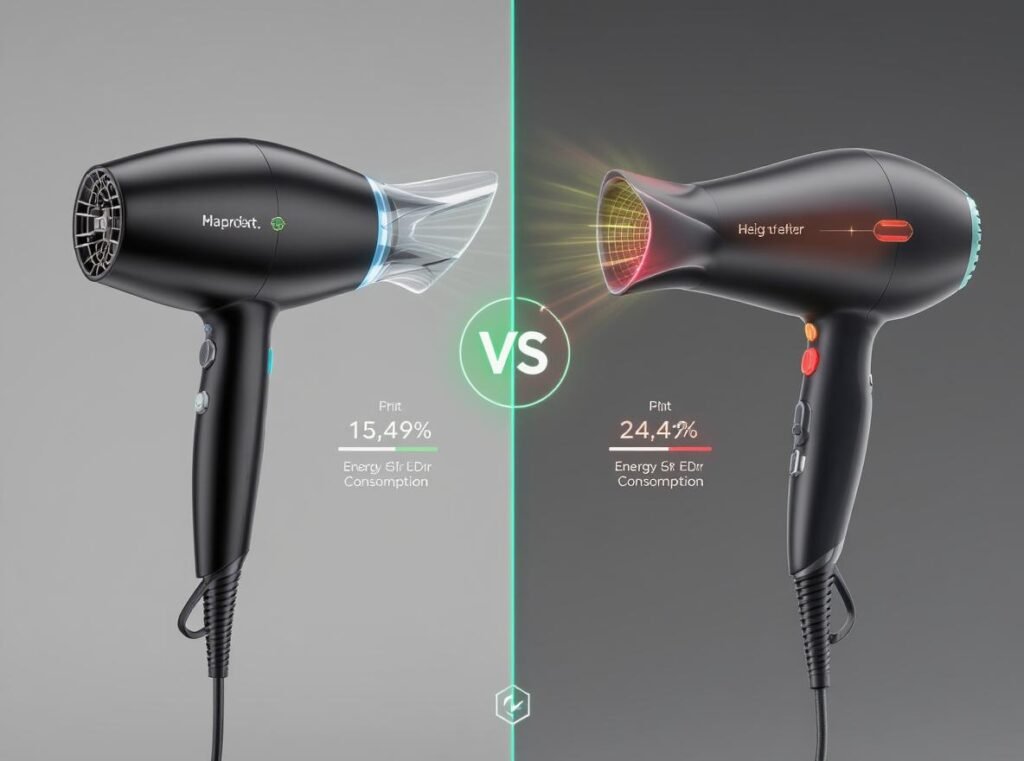
The performance differences between traditional and energy-efficient models are significant:
Traditional dryers often require 20-30 minutes for complete drying, while high-speed models can reduce this time by half. This dramatic time reduction translates directly to energy savings and improved user experience.
Heat distribution improvements in modern dryers prevent hot spots and reduce hair damage. Even temperature control not only protects hair health but also prevents energy waste from overheating.
Advanced motor technology, particularly brushless motors, provides longer operational life and requires less maintenance. This reduces overall environmental impact through extended product lifespan and fewer replacements.
Energy consumption varies dramatically between models. Traditional dryers typically consume 1800-2000 watts, while energy-efficient alternatives operate at 1000-1400 watts without sacrificing performance.
| Feature | Traditional Dryers | Energy-Efficient Models |
|---|---|---|
| Drying Time | 20-30 minutes | 10-15 minutes |
| Energy Consumption | 1800-2000 watts | 1000-1400 watts |
| Heat Distribution | Uneven, hot spots | Even, controlled |
| Hair Damage Risk | Higher | Reduced |
| Motor Lifespan | Standard | Extended with brushless |
| Environmental Impact | Higher carbon footprint | Reduced energy usage |
What Should Wholesalers Consider When Choosing Eco-Friendly Hair Dryers?
Wholesalers and distributors must balance sustainability with business requirements when selecting eco-friendly hair dryers.
Wholesalers should prioritize material composition, energy efficiency ratings, relevant certifications, durability for reduced replacement frequency, manufacturer recycling programs, and sustainable packaging. These factors ensure both environmental responsibility and business viability.

Key wholesale considerations include:
Material composition analysis helps identify products with recycled content and recyclable components. Models like the Mermade Hair M Ionic with 20% recycled plastic content demonstrate manufacturer commitment to sustainable practices.
Energy efficiency ratings provide quantifiable environmental benefits. Lower wattage models that maintain performance offer retailers compelling selling points for environmentally conscious consumers.
Certification compliance ensures products meet environmental and safety standards. Look for compliance with Extended Producer Responsibility (EPR) regulations, BIS certification, and Plastic Waste Management Rules.
Durability assessment impacts long-term environmental benefits. Products like the Ibiza Hair Kristal 3600, designed for longevity, reduce replacement frequency and overall waste generation.
Manufacturer recycling programs add value for environmentally conscious retailers. Programs like Paul Mitchell’s Tool Recycling Program demonstrate ongoing commitment to sustainability.
Packaging considerations include minimal use of materials and recyclable components. Eco-friendly models often feature reduced packaging and recycled materials, appealing to sustainability-focused consumers.
Professional salon applications require balancing sustainability with performance demands. The Conason P1C and similar high-speed models offer professional-grade results while incorporating energy-efficient technology.
Are There Certification Standards for Sustainable Hair Dryers?
Understanding certification standards helps businesses identify truly sustainable hair dryer options.
Current certification standards for sustainable hair dryers include Extended Producer Responsibility (EPR) compliance, BIS certification, Plastic Waste Management Rules compliance, and Energy Efficiency Labels. These standards ensure environmental responsibility and safety compliance.
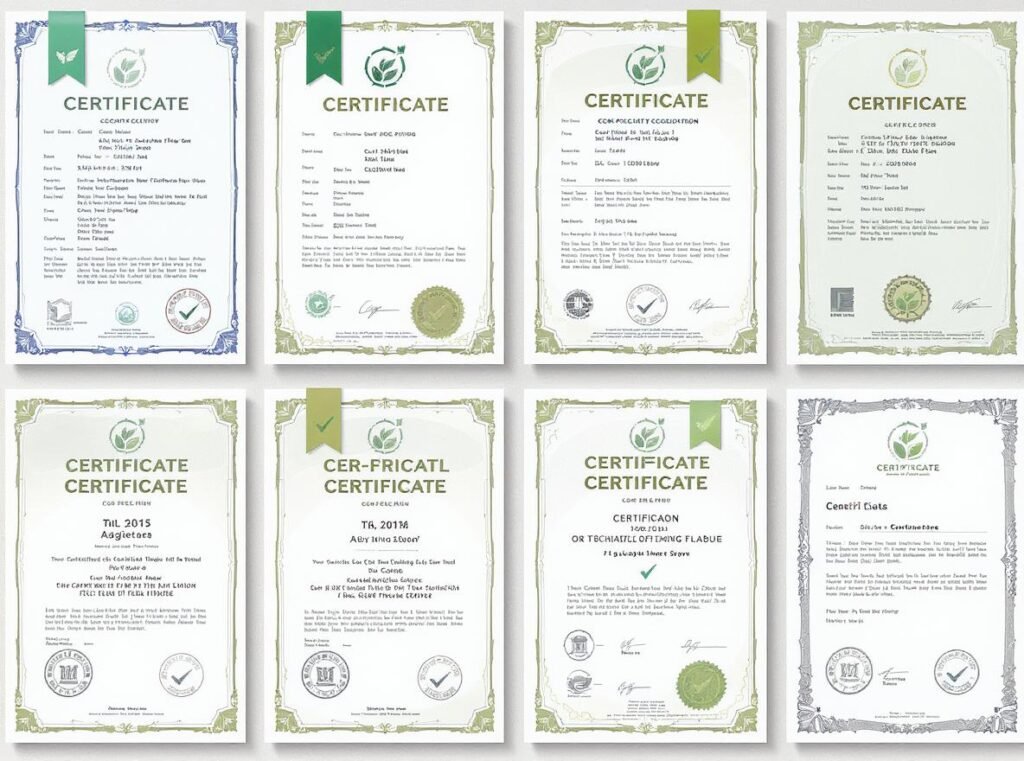
Relevant certification standards include:
Extended Producer Responsibility (EPR) regulations ensure manufacturers manage electronic waste responsibly throughout product lifecycles. This certification indicates commitment to sustainable product design and end-of-life management.
BIS Certification in India confirms safety and quality standards while addressing environmental considerations. This certification ensures products meet stringent safety requirements and environmental impact standards.
Plastic Waste Management Rules mandate responsible plastic use and disposal practices. Manufacturers must demonstrate compliance with regulations governing plastic content, recyclability, and disposal methods.
Energy Efficiency Labels indicate lower energy consumption and reduced environmental impact. These labels vary by region but provide consumers with standardized information about energy performance.
CE marking for European markets ensures compliance with health, safety, and environmental protection standards. This certification covers electromagnetic compatibility and electrical safety while addressing environmental considerations.
Additional certifications may include ISO 14001 environmental management system compliance, indicating systematic approaches to environmental responsibility throughout manufacturing processes.
What’s the Future of Recyclable Hair Dryer Technology?
The future of recyclable hair dryer technology looks promising as manufacturers invest in sustainable innovation.
Future developments in recyclable hair dryer technology include design for disassembly principles, increased use of recycled materials, expanded manufacturer take-back programs, advances in biodegradable components, and greater regulatory pressure for eco-design standards.
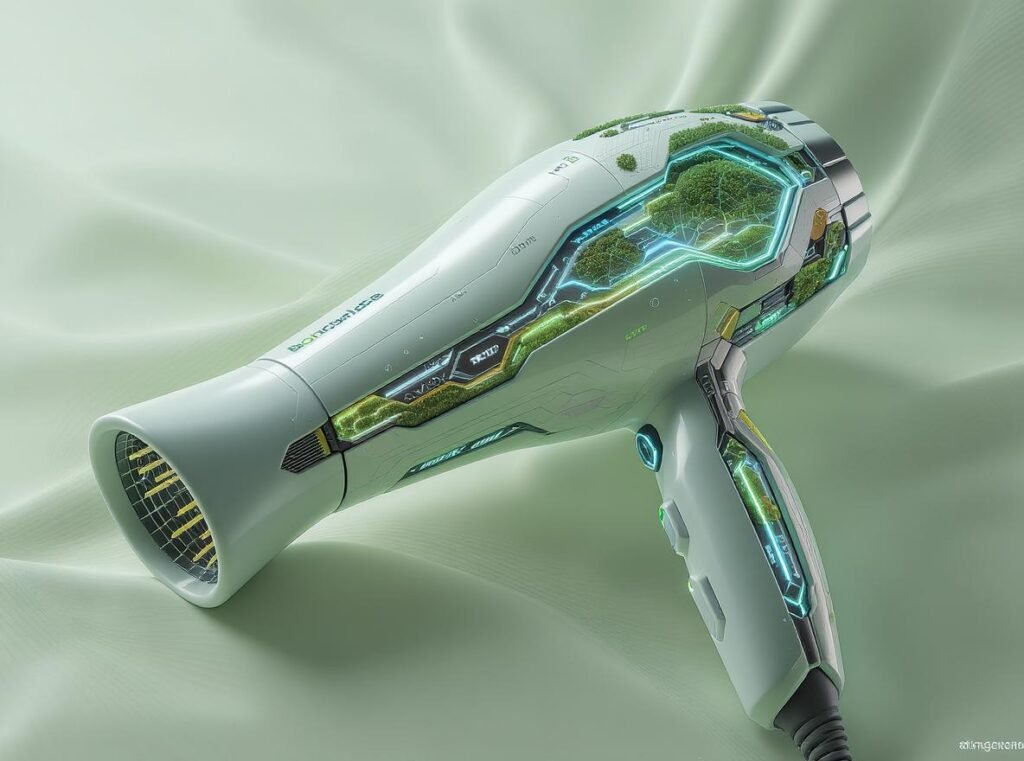
Emerging technologies and trends include:
Design for disassembly principles will become standard, making products easier to repair and recycle. This approach allows consumers to replace individual components rather than entire units, extending product life and reducing waste.
Increased use of recycled materials will expand beyond current 20% recycled plastic content. Future models may incorporate higher percentages of recycled materials in both casings and internal components.
Manufacturer take-back programs will expand beyond current initiatives like Paul Mitchell’s Tool Recycling Program. More brands will offer comprehensive recycling services for their products regardless of age or condition.
Biodegradable components represent the next frontier in sustainable design. While durability requirements limit current applications, research continues into compostable plastics and renewable materials for non-critical components.
Regulatory pressure will drive innovation in eco-design standards. Government regulations will increasingly mandate recyclability, energy efficiency, and sustainable material use in small appliances.
Advanced recycling partnerships between manufacturers and recycling facilities will create closed-loop systems. Old hair dryers will become raw materials for new products, establishing truly circular economy models.
Smart technology integration will enable predictive maintenance and optimal performance monitoring. This technology extends product life by alerting users to maintenance needs before failures occur.
How Can Businesses Promote Sustainable Hair Dryer Practices?
Businesses play a crucial role in promoting sustainable hair dryer practices throughout the supply chain.
Businesses can promote sustainability by educating consumers about recycling options, offering take-back or trade-in programs, stocking eco-friendly models, partnering with recycling organizations, and highlighting sustainability certifications in marketing efforts.

Effective promotional strategies include:
Consumer education initiatives help customers understand proper disposal methods and recycling options. Providing clear information about local recycling centers, e-waste programs, and manufacturer take-back services empowers responsible decision-making.
Take-back and trade-in programs encourage proper disposal while building customer loyalty. Following Paul Mitchell’s example, businesses can accept old styling tools regardless of brand, demonstrating environmental commitment.
Stocking eco-friendly models from brands like Mermade Hair, Parlux, and Twin Turbo provides customers with sustainable options. Highlighting models with recycled content, energy efficiency, and durability appeals to environmentally conscious consumers.
Partnerships with recycling organizations ensure responsible e-waste handling. Collaborating with certified recycling facilities creates convenient disposal options for customers while supporting proper environmental practices.
Marketing sustainability efforts builds brand reputation and attracts environmentally conscious consumers. Highlighting certifications, recycling programs, and eco-friendly features differentiates businesses in competitive markets.
Professional salons can lead by example through sustainable equipment choices. Showcasing energy-efficient models like the Conason P1C demonstrates commitment to environmental responsibility while maintaining professional standards.
Wholesale businesses should prioritize suppliers with comprehensive sustainability programs. Supporting manufacturers with strong environmental commitments creates market demand for more sustainable products and encourages continued innovation.
Summary
Recyclable hair dryers are partially available through specialized e-waste programs, with manufacturers increasingly developing eco-friendly models using recycled materials and energy-efficient designs. While fully recyclable dryers aren’t yet standard, sustainable options from brands like Mermade Hair, Parlux, and Twin Turbo continue improving through innovations in materials, energy efficiency, and design principles.
For wholesalers and businesses seeking sustainable hair dryer options, explore our professional-grade models including the energy-efficient Conason P1C high-speed dryer. Visit our complete product collection to discover sustainable styling solutions for your customers, or contact us for wholesale inquiries about eco-friendly hair dryer options that meet both performance and environmental standards.

